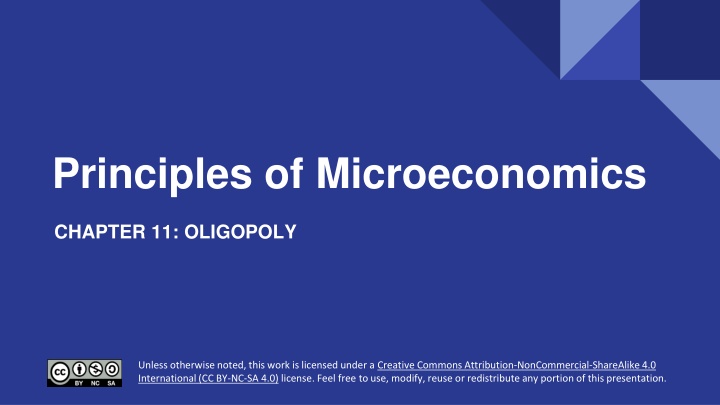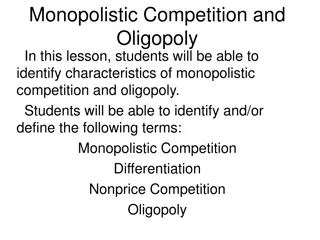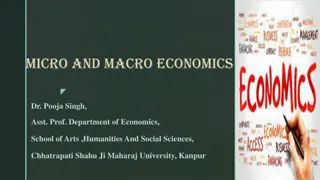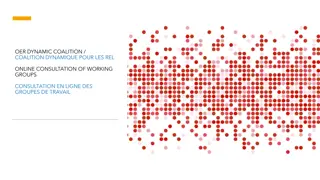
Understand Oligopoly Market Structure and Game Theory
Explore the concept of oligopoly, collusion, game theory, and the prisoner's dilemma in microeconomics. Learn why oligopolies exist, the impact of barriers to entry, and how firms navigate between competition and cooperation. Discover the dynamics of duopoly through payoff matrices.
Download Presentation

Please find below an Image/Link to download the presentation.
The content on the website is provided AS IS for your information and personal use only. It may not be sold, licensed, or shared on other websites without obtaining consent from the author. If you encounter any issues during the download, it is possible that the publisher has removed the file from their server.
You are allowed to download the files provided on this website for personal or commercial use, subject to the condition that they are used lawfully. All files are the property of their respective owners.
The content on the website is provided AS IS for your information and personal use only. It may not be sold, licensed, or shared on other websites without obtaining consent from the author.
E N D
Presentation Transcript
Principles of Microeconomics CHAPTER 11: OLIGOPOLY Unless otherwise noted, this work is licensed under a Creative Commons Attribution-NonCommercial-ShareAlike 4.0 International (CC BY-NC-SA 4.0) license. Feel free to use, modify, reuse or redistribute any portion of this presentation.
Learning Outcomes At the end of this chapter, you will be able to: Explain why oligopolies exist Contrast collusion and competition Interpret and analyze the prisoner s dilemma problem Explain the role of game theory in understanding the behaviour of oligopolies
11.1 Oligopoly Market Structure A market structure where a small number of interdependent firms compete. 1. Firms are large and know the actions of one another. 2. Barriers to entry exist to avoid new competition.
11.1 Why do Oligopolies exist: Barriers to Entry A combination of the barriers to entry that create monopolies and the product differentiation that characterizes monopolistic competition can create the setting for an oligopoly.
11.2 Collusion or Competition When firms act together in this way to reduce output and keep prices high, it is called collusion. A group of firms that have a formal agreement to collude to produce the monopoly output and sell at the monopoly price is called a cartel.
11.2 Game Theory The study of how individuals/firms make decisions when their own goals depend on their interactions with others. All games have the same characteristics: 1. Rules that determine what you can and cannot do 2. Strategies that players may use to attain their goal 3. Payoffs that show the result of the interaction between player strategies
11.2 Duopoly A duopoly is a game between 2 or more players where each player acts simultaneously. To solve a duopoly, we use a Payoff Matrix as seen in the example
11.3 The Prisoner's Dilemma I The prisoner s dilemma is a scenario in which the gains from cooperation are larger than the rewards from pursuing self-interest. It applies well to oligopoly. The story behind the prisoner s dilemma goes like this: There are two prisoners (players of the game), who have two strategies: confess and deny the crime, and serve a jail sentence (payoffs)
11.3 The Prisoner's Dilemma II The game theory situation facing the two prisoners is in this figure.
11.4 The Oligopoly Version of the Prisoner's Dilemma I The members of an oligopoly can face a prisoner s dilemma, also. If each of the oligopolists cooperates in holding down output, then high monopoly profits are possible. Each oligopolist, however, must worry that while it is holding down output, other firms are taking advantage of the high price by raising output and earning higher profits.
11.4 The Oligopoly Version of the Prisoner's Dilemma II Fig 11.2
11.5 Cartels I A cartel is an agreement among competing firms to collude in order to attain higher profits. Cartels usually occur in an oligopolistic industry, where the number of sellers is small and the products being traded are homogeneous.
11.5 Cartels III Fig 11.3
11.5 Sequential Game A Sequential Game between 2 or more players one where players take turns. To solve a duopoly, we use a Decision Tree as seen in the example.
11.6 KEY TERMS Single-shot games Repeated games Prisoner s dilemma Dominant strategy Nash equilibrium Duopoly Kinked demand Oligopoly Monopoly Collusion Cartel Game theory Players of the game Strategies Payoffs






















